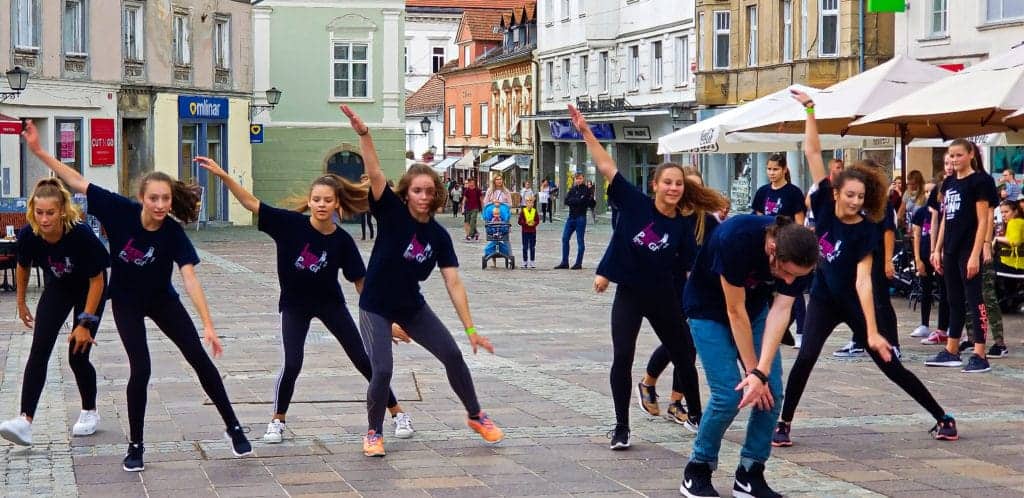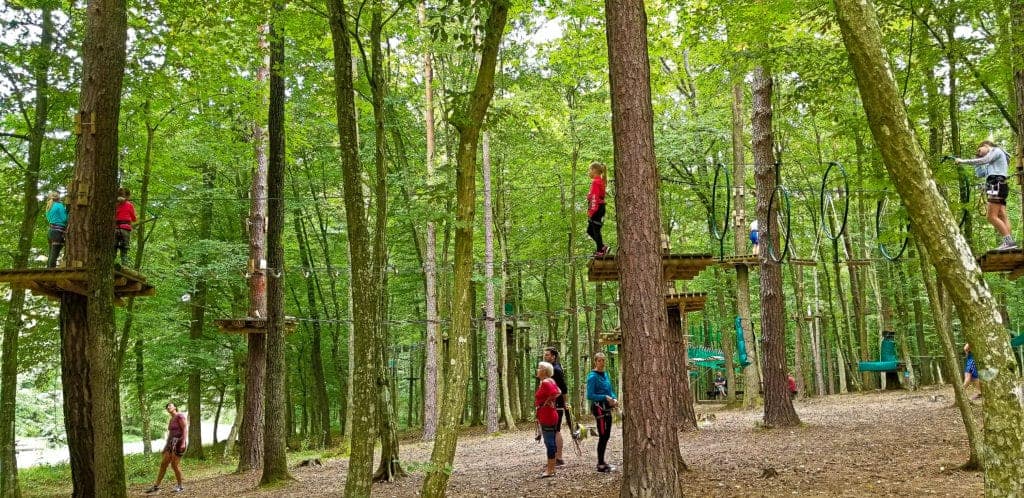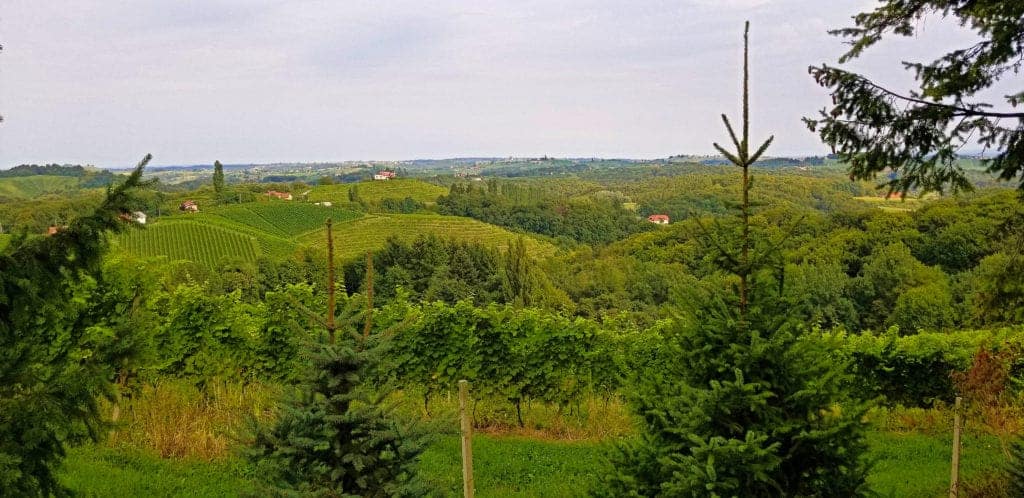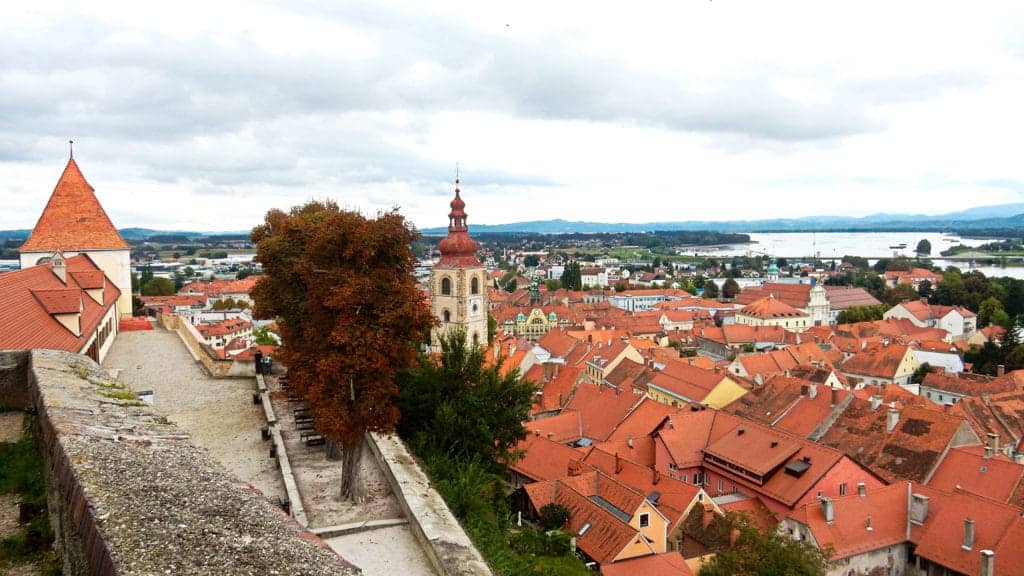Introduction to Slovenia

We have just spent our first week in Slovenia. Before I introduce you to Slovenia I want to finish off some of the things that we saw at the end of our trip in Hungary. I mentioned that we saw a statue of Columbo and Dog in Budapest one evening. I didn’t tell you that we saw a man with his pet on a leash near the statue. His pet was quite hesitant to approach Dog. When he finally got closer he sniffed around the bronze statue. The pet was a fox. I can’t say that I have ever seen a fox on a leash before.
We walked past a very large park that was full of people sitting on the grass, having a good time. Throughout the park were grills, level with the ground. It turned out that all these grills were small fountains. It was very effective. We asked someone if all these people were waiting for something to start, possibly an outdoor concert or show. We were told no, they were just enjoying an evening in the park.
Mike and I visited Gödöllő Palace which was a favourite palace of Empress Elisabeth, more commonly known as Sisi. Sisi appears to have been a very popular figure throughout the former Austro-Hungarian empire. She was married to Emperor Franz Josef and was assassinated when she was 60 years old, in 1898. She was very much into health and beauty. In one castle that we saw on a previous trip, she had had rubber bands hung over the door in her bedroom for exercise. After the age of 32 she would not allow any photographs of her to be taken. She wanted to always look young and beautiful. For some reason Sisi quite interests me. I think I am going to try and find a biography of her at the library. e-books and on-line libraries are great for travellers. At the end of wandering around Gödöllő Palace on our own, Mike and I found out that there was an English audio guide available which had not been mentioned when we purchased our tickets. We were not pleased.
Enough said about our time in Hungary, on to Slovenia.
Slovenia is quite a small country. It is about 20,000 square kilometers or less than 8,000 square miles. For Canadians, this is less than ½ the size of Nova Scotia. For Americans, this is about the size of New Jersey or Massachusetts. Two million people live in Slovenia. Mike and I find the recent history in this part of the world very interesting and I have included some information at the end of this post. The literature that we have seen says that English is spoken very often. We didn’t find this to be true in rural Slovenia. I expect that it is true in the larger cities. Slovenia’s education ranks as the 12th best in the world and 4th best in the European Union. Slovenia’s major university is ranked in the top 3% in the world.
Mike has a real problem with the road designers in this country, maybe they were educated elsewhere. He doesn’t understand why there are bends in the road in all sorts of places where none need to be. Straight stretches don’t last for very long. Many of the farmer’s fields that we have seen are quite narrow. Mike says that since large fields are much more productive this must mean that each field is owned by a different farmer. I am not sure if that is true but we hope to talk to someone local and get some accurate input. We have seen some large tractors and combines here, so they do exist.
The first place that we stayed was just inside the Hungarian/Slovenian border. It was at the edge of a national park. Our campsite adjoined a parking lot for the park and for an adventure complex. In the park was a small lake that we walked around, an even smaller chapel and lots of bike paths leading to different villages and town. Twice we biked 40 km around different areas. I have a car seat with a cutout where the tailbone goes. I now use that on my chair when I get back from one of those rides. My pedal and electric sensor where giving me a bit of a problem but my wonderful husband molded new parts to fix the problem. Would I ever be in trouble without him.

Across from our campsite, was an adventure park. It had all sorts of ropes and walks and tubes strung between trees for different activities. You started at one end and kept going. Mike and I just stood there and watched some kids going through the park. I believe that they must have been there before as a group because they were very quick to hook and unhook their safety lines and seemed to know what to do when they got to each obstacle or activity. It was fun watching them but that is all we did.
30 minutes away was the town of Jeruzalem. It is a tiny settlement of about 40 people. I had to go and visit it, just because of the name. It is in Slovenia’s largest wine region. The vineyards are all up and down the hills. The scenery is very impressive. Apparently, the German crusaders where also impressed and settled here in the 13th century on their way back from a crusade in Jerusalem. The new settlement was therefore named Jeruzalem and the surrounding hills were named after the apostles.

Mike and I spent almost a week in this area and then left for a city about one hour away. We are now staying 5 km from the centre of Maribor, the second largest city in Slovenia. It is the second largest city in Slovenia with a population of almost 100,000 people. It has a vibrant feel with university students everywhere and a very large pedestrian area. Both our campsite and Maribor are on the banks of the Drava river. We are actually camping at an outdoor centre with a café, restaurant, canoe rentals, playgrounds and more. In this area, the woods on both sides of the river form a national park. Officially, in a national park your boat can’t have a motor. There is a launch place for our boat next to where we are camped, but it is off a parking lot for a chocolate factory. We have been told that we can probably get away with having our boat and motor here as we will be quickly leaving the park area and heading west. My concern is actually trying to launch the boat in a fairly public area. So far it hasn’t been a problem since we have had rain every day. We are supposed to have one or two days without rain and then it will start again for the next week. We haven’t even unpacked our bikes here and the bike path into town is one of the reasons we chose this place. The other reason was the river and we haven’t unpacked our boat either.
We did drive to a town called Ptuj (pronounced P-too-ee) yesterday. I believe that it is the oldest city in Slovenia. We didn’t really see much of the town, we just toured Ptuj Castle. It is a museum with different sections including paintings, armory, glass icons and of course, furnished rooms in the castle. We expect to go back again and wander around the town itself.

The couple that runs Drava Centre where we are camping are very nice. We called them before we came to make sure that they could take a vehicle our size. They said yes but that there was concern that cars sometimes overflowed the parking lot into the section for campers. We got to within two minutes of the campground when we couldn’t go any further. We were on a small road and came to a section that had large circular cement obstacles on both sides of the road. These cement obstacles were intended to narrow the road even further, which they did. A car could pass through but nothing else. We later found out that this section of road had a 3.5 tonne limit, we are 10 tonne. We unhooked the car and drove around to try and find another route into this park. We did find a very narrow one lane road into Drava Centre. When we got to Drava Centre we saw that half the area where campers go was cordoned off. Cars were parked in the other camping spots. The man we had talked with was out at the time. We were guessing that the area was cordoned off so that no-one could take the space that we would need. With a lot of maneuvering, in a very tight area, Mike managed to back into this spot once I removed the ribbons across the parking lot. We were really hoping that we were correct and that it was being saved for us. It was. Every morning we go over to the café for a cappuccino before we get on with our day. How nice.
For those, like Mike and I, who didn’t know much about Slovenia and its heritage, at least in the last century, I have added some history that we have found interesting. Below is nothing to do with our travels, just a quick history lesson which you can feel free to skip if you want.
Slovenia was part of the Austro-Hungarian empire that was dissolved after WWI. Over the next ten years different republics joined together at different times and, in 1929, formed Yugoslavia. During WW II Slovenia was completely annexed into both Nazi Germany and Fascist Italy. After the war ended Yugoslavia re-emerged as a socialist state with Tito as their leader. Tito and Stalin had a split in 1948 and there were more economic and personal freedoms in Yugoslavia than in the rest of the Eastern Bloc. Tito promoted a model of market socialism, where firms were socially owned by their employees and competed with each other in open and free markets.
I found this note on the internet from Tito to Stalin:
Stop sending people to kill me. We’ve already captured five of them, one of them with a bomb and another with a rifle. […] If you don’t stop sending killers, I’ll send one to Moscow, and I won’t have to send a second.
— Josip Broz Tito
My impressions of Tito were always quite negative, but I don’t think that I had the full story. Tito was definitely authoritarian and repressed his political opponents. Today he is considered to have been a benevolent dictator. Tito was very popular both in Yugoslavia and abroad.
Tito died of gangrene in 1980. Based on the number of attending politicians and state delegations, at the time it was the largest state funeral in history; this concentration of dignitaries would be unmatched until the funeral of Pope John Paul II in 2005 and the memorial service of Nelson Mandela in 2013. Those who attended included four kings, 31 presidents, six princes, 22 prime ministers and 47 ministers of foreign affairs. They came from both sides of the Cold War, from 128 different countries out of 154 UN members at the time.
In 1990 almost 90% of the Slovenian electorate voted for an independent Slovenia. Croatia also wanted independence at the same time. Things went quite differently for the two republics. Croatia attempted to replace the police in the Serb populated area by force. These armed conflicts marked the beginning of the Yugoslav war. Slovenia attempted to replace the Yugoslav frontier police which provoked some regional armed conflicts but finished with a minimal number of victims. A similar attempt in Bosnia and Herzegovina led to a war that lasted more than three years.
In 1991, Slovenia and Croatia became the first republics to declare independence from Yugoslavia. The international community pressured Slovenia and Croatia to place a three-month moratorium on their independence. During these three months, the Yugoslav Army completed its pull-out from Slovenia, but in Croatia, a bloody war broke out.
I am not sure, but I think, in my simplistic view, that the difference between the peacefulness of the Slovenia split and the violence in Croatia is because there were a lot more Serbs in Croatia and they didn’t want to go from being in the majority when they were part of Yugoslavia, to a minority in Croatia.
One Slovenian told us how her brother was in Belgrade in his last year at military school when the 10-day war for Slovenian independence was fought. He had to leave and return to Slovenia without graduating.

Leave a Reply